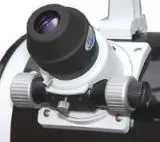- Details
- More images
- Customer-tip
Products description

The Skywatcher Explorer 130PDS is checked and adjusted by us before delivery. The focuser is set.
All Newton telescopes should be adjusted before first use and then regularly
to get a sharp picture. We adjust all of our Newton before they leave our house.
How we adjust: About us
Skywatcher Explorer 130PDS 130mm 650mm 5.1 '' f / 5 Photo Newton
Telescope with 130mm aperture and 650mm focal lengthSkywatcher telescope 130PDS focuser, a 2 "Crayford focuser and 1:10 micro reduction to allow an exact focusing complements this high quality device.The connection of the usual cameras and CCD cameras is no problem 1.25 "plug diameter is included and thus 1.25 '' eyepieces can be used.Basics:
There are not only alternators in the car! :-)
Newton telescopes are considered (and are) basically high-powered telescopes. From f / 5 I define again as particularly bright. When observing the moon, we definitely recommend a filter to reduce the glare effect. - The moon reflects so much light that the light should be attenuated (especially at low magnification). Also note the dark adaptation of the eye. For example, if I want to observe deep sky objects after the moon, the adaptation of the eye takes a certain amount of time before I can perceive the much fainter ones again in detail.
And that brings us to the objects that such a Newton can show in abundance - visually and photographically!
Deep sky objects (ie galaxies, nebulae, star clusters ...) do not require a high magnification, but a corresponding light gathering power. For photography, this also means the shortest possible exposure time for a shot.
Planets (and moon) require a higher magnification and thus a Barlow lens ???? for focal length extension.
So with this device also beautiful details on the moon and planets can be seen! So you do not have to do without this field of application:
An (almost) all-rounder among the telescopes focusing on deep sky.
The parabolic primary mirror in conjunction with the relatively small secondary mirror ensures a good correction of the image field / focus and thus sharpness and contrast richness. Therefore, not only a bright image of deep sky objects is a pleasure. Moon and Panets offer a wealth of detail (fine craters and grooves on the moon, cloud bands on Jupiter or the rings of Saturn, for example), which will delight you in every area of astronomical observations.
Due to the versatility of this telescope and the reasonable price, this device is also very interesting for school astronomy.
This Newton telescope is universally applicable and suitable for lunar and planetary observations (here we recommend a Barlow lens for higher magnifications). Likewise, it is bright enough to go on a successful expedition on deep sky objects, such as galaxies (M31, Andromeda Nebula, or M81 in the Big Bear), the Orion Nebula, or the globular cluster M13.
Brighter deep-sky objects, such as the Orion Nebula and the Andromeda Galaxy, are beautiful viewing objects. At 130mm opening, I already have a decent light collection capacity. Therefore, galaxies and nebulae are visible in the high-contrast image. Star clusters show their beauty and clearly stand out against the darker background.
The 2 "Crayford focuser with 1:10 reduction:
The Dobson is equipped with a smooth and precisely worked 2 "Crayford focuser with a reduction for 1.25" accessories. You can thus use powerful 2 "eyepieces, a bright picture and a broader view is possible.All 1.25" eyepieces can of course also be used.
Since the drawer is ball-bearing, heavy and accurate adjustments are guaranteed for heavy accessories.
To achieve a particularly accurate focus, the extract has a 1:10 micro reduction.
Please do not hesitate to ask for our advice (including the meaningful and rich accessories). Your wishes are important to us!
Product advantages:
+ For lunar, planetary and bright deep-sky observations
+ Through 130mm opening good light accumulation power (f / 5)
+ PDS version with DualSpeed focuser for sensitive focusing
by 1:10 reduction
+ Optimized for astrophotography with enough back focus for all popular cameras
Please note:
- Without mount and tripod
- We recommend further accessories, such as detail eyepieces, Barlow lens, filters
Delivery:
Skywatcher Explorer 130PDS / 650
Prism rail & clamps for fixing the tube
28mm LET 2 "eyepiece
2 "to 1.25" adapter with T2 connection
6x30 viewfinder
Technical data at a glance:
Type: reflector telescope / Newton
Color: Black
Lens diameter: 130 mm
Focal length: 650 mm (f / 5)
Resolution: 0.58 arc seconds
Limit size: 12.4 mag
2 "Crayford focuser, reducible to 1.25 '', with T2 connector
SUPER 25 mm overview eyepiece
6x30 optical viewfinder
Catch and zenith mirror with
Centering marking to simplify the adjustment
Magnifications: 26x
Weight (tube + clamps): approx. 4 kg
Customers who bought this product also bought the following products:
Shipping time:  In stock + testing
In stock + testing
 In stock + testing
In stock + testingOur previous price 186,00 EUR Now only 169,00 EURyou save 9% / 17,00 EUR
19 % VAT incl. excl. Shipping costs
Shipping time:  In stock + testing
In stock + testing
 In stock + testing
In stock + testing49,00 EUR
19 % VAT incl. excl. Shipping costs
Shipping time:  In stock + testing
In stock + testing
 In stock + testing
In stock + testingOur previous price 299,00 EUR Now only 279,00 EURyou save 7% / 20,00 EUR
19 % VAT incl. excl. Shipping costs
Shipping time:  In stock + testing
In stock + testing
 In stock + testing
In stock + testing76,00 EUR
19 % VAT incl. excl. Shipping costs
Shipping time:  In stock + testing
In stock + testing
 In stock + testing
In stock + testingOur previous price 28,99 EUR Now only 23,99 EURyou save 17% / 5,00 EUR
19 % VAT incl. excl. Shipping costs
Shipping time:  In stock + testing
In stock + testing
 In stock + testing
In stock + testingOur previous price 365,00 EUR Now only 292,00 EURyou save 20% / 73,00 EUR
19 % VAT incl. excl. Shipping costs
This Product was added to our catalogue on 04/06/2012.
Categories
Quick purchase
Welcome back!
Last viewed:
Manufacturer
Shipping country









